|
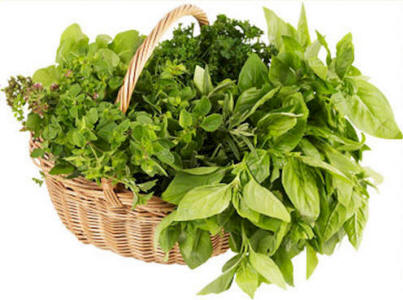

For as long as humans have been cooking, we have been cooking
with herbs. In our eternal effort to make foods more agreeable, prehistoric
cooks plucked a few leaves from wild plants and added them to the fire or stew
pot in a practice that was already ancient when later generations took the first
bold steps towards agriculture and civilization. Herbs and spices are so
fundamental and essential to the art of cooking that I often wonder if preparing
food without them can properly be called cooking at all.
We are going to take a detailed look at the use of culinary
herbs, with side trips into their cultivation, harvesting, drying, and storage,
but first we must settle one burning issue: the proper pronunciation of the word
herb. The question is, should one pronounce the h or not? Is it pronounced
hurb or urb?
At the risk of incurring the wrath of many of my readers, I
hereby state categorically that there is only one correct answer to this age-old
question-both are correct. Yes, ladies and gentlemen, you heard it here first,
both hurb and urb are correct pronunciations of the word herb.
Like so many other words, the difference in pronunciation is a regional
difference, so in order to avoid the scorn of your friends and family I strongly
suggest you pronounce it like your parents and neighbors pronounce it.
Generally speaking, most Americans (90 percent more or less)
pronounce it urb while most other English speakers prefer to pronounce
it hurb. Historically, the word is descended from the Old French word
herbe, and we have adopted several "h" words from French. The initial h is
always silent in French, and English speakers have retained the silent h in many
French words (honor, honest, hour, and heir for example) while pronouncing it in
others (haste and hostel).
Linguists believe that in English the h in herb was originally
silent, as evidenced by the fact that the word was frequently spelled erbe in
older English texts. American colonists brought this pronunciation with them
from England and have held onto it over the years. One account I have read
suggests that pronouncing the initial h in England came about as a reaction to
the fact that certain "lower" classes of English speakers habitually drop all
initial h sounds (à la Eliza Doolittle), so cultured English speakers began
pronouncing initial h sounds so as not to be confused with the rowdy masses.
To further confuse matters, Americans also say herbal with a
silent h, but choose to pronounce the h in related words such as herbaceous,
herbivore, and herbicide. Go figure. Regardless of how you pronounce it, rest
assured that your pronunciation is correct.
Now that we have finally put to rest the eternal question of how
to properly pronounce the word, let's take a crack at defining it.
To a botanist, an herb (or a herb if you prefer to pronounce the
h) is any plant that has fleshy stems and doesn't produce woody matter.
Obviously, this includes jillions of plants that have nothing to do with
cooking. To the layman, an herb is any plant that is used in cooking or for
medicinal purposes, and since I don't know the first thing about the medicinal
uses of plants or their curative powers, whether real or imagined, we'll stick
to the culinary herbs here.
As I have already alluded, the term herb used in the culinary
sense doesn't really have a technical definition, so different people's
definitions will vary. For the purposes of this article I will define a culinary
herb as a plant whose leaves or stems are used to flavor foods. Notice that this
definition excludes several herbaceous plants (such as lettuce and other salad
greens) because they are foods themselves rather than a flavoring for other
foods. Get it? This definition also excludes parts of plants other than the
leaves and stems, including roots, tubers, seeds, flowers, and fruits. These all
play major roles in the foods of the world, but they're not in this essay.
Growing Herbs
So, you would like to grow your own fresh herbs. I don't blame
you, considering the price of fresh herbs in the supermarket. And you obviously
agree with me the dried herbs are a poor substitute for the fresh thing.
Growing your own herbs is easier than you might expect. Most of
them form small, compact bushes that don't take up too much room in the garden,
and most are small enough to be grown indoors in containers if you like.
Following are a few general rules that apply to most of the herbs we use in our
kitchens.
Keep in mind that most of the herbs we use in cooking are native
to the Mediterranean, the Middle East, and other tropical and subtropical
climates. Therefore, most of them require full sun and well-drained-even sandy
or rocky-soil. As a general rule, culinary herbs don't require fertilizing, and
most will thrive in soils that might be too nutrient-poor for other plants.
Many of the culinary herbs are treated as annuals in northern
climates, even though they may be grown as perennials in their native regions.
These may be potted and brought indoors to protect them from frost, or simply
replanted in the spring after the last freeze of the season. Most can be started
from seeds that are readily available from garden centers and mail-order
sources, but I prefer to transplant seedlings I buy at my local nurseries.
The scope of this book isn't broad enough to cover in detail the
horticultural requirements of every culinary herb. For that I suggest you buy a
good book on growing herbs.
Preserving Herbs
I have three rules concerning the use of fresh herbs:
- Fresh Herb Rule #1-Always use fresh herbs if possible
- Fresh Herb Rule #2-Use frozen herbs if fresh herbs aren't
available
- Fresh Herb Rule #3-Use dried herbs only if fresh or frozen
herbs aren't available or if you find yourself adrift at sea on a small raft
with nothing but dried herbs
Fresh herbs should always be used if at all possible because any
attempt to preserve herbs by any means invariably results in a loss of the
essential oils that give every culinary herb its unique flavor. Frozen herbs are
the next best alternative, and the use of dried herbs should be considered a
measure of last resort.
Fresh herbs may be obtained from your own garden or window box,
from a growing number of supermarkets and produce specialists, or from your
neighbor's herb garden if you aren't above a minor breach of culinary etiquette
and misdemeanor criminal activity.
Frozen herbs, although available commercially on a limited basis,
are best procured by freezing fresh herbs obtained in one of the three manners
described above. Since most fresh herbs will lose their texture and color as a
result of freezing and won't typically serve as an attractive garnish, it is
best to chop them prior to freezing. Many sources recommend freezing
pre-measured amounts (such as 1 tablespoon, or 15 ml) in ice cube trays with
just enough water to cover, and you are certainly welcome to use this method if
it appeals to you. However, the water may be an unwelcome addition to your dish,
especially if you are using the herbs to flavor a sauce or gravy. I recommend
simply freezing the chopped herbs in plastic freezer bags or small glass jars
with tightly fitting lids. Empty herb bottles from your supermarket and baby
food jars are ideal. You will probably be surprised at how much of the original
flavor of the herb is preserved intact by freezing fresh herbs, and they will
retain most of their flavor for up to a year in your freezer.
Some fresh herbs dry better than others. Examples of herbs that
are well worth the effort of drying include thyme, rosemary, oregano, marjoram,
and sage. Don't bother drying (or buying already dried) parsley, basil, chives,
cilantro (coriander leaves), dill, or any of the more subtly flavored herbs. You
will achieve a better taste and save considerable money by adding finely chopped
sawdust to your favorite recipes. If you must dry fresh herbs for reasons of
practicality or economy, hang them tied together in bunches upside down in a
cool, dry, dark place. The typical coat closet makes a pretty good place to hang
your herbs. Once they are dry and brittle (2 to 4 weeks for most herbs) you can
then rub them between your hands over a large piece of paper or inside a paper
bag to collect the dried flakes. Store these in small airtight containers,
preferably in the refrigerator or freezer. Avoid the temptation to dry them in
the oven, microwave, or food dehydrator because even a small amount of heat will
destroy many of the essential oils and your efforts will be rewarded with large
quantities of that sawdust stuff we've already talked about.
Cooking with Herbs
As I hope I have already made abundantly clear, you should use
fresh herbs whenever possible. And when using fresh herbs, feel free to adjust
the amount you use based on the potency of the herbs, and on your own
preferences. The flavor of even the freshest herbs will vary based on the time
of year, their growing conditions, and even the time of day they were harvested.
Personally, I am partial to the unique flavors of several fresh herbs and I tend
to use more than your typical classically trained French chef might. As with all
matters of taste, this is another case of "to each his own."
Most herbs are best added to a dish during the last five or ten
minutes of cooking, or even as a last-minute garnish. Heat is very unkind to the
essential oils that give herbs their taste, and prolonged cooking will reduce
even the most pungent herb to a mere shadow of itself. Dried herbs can tolerate
a little more time on the fire because they must undergo a rehydration process
before they begin to lose their unique flavors, but the same rule applies-the
less time they are cooked, the better.
The standard rule of thumb for substituting dried herbs for fresh
is one measure of dried herbs for three measures of fresh. This is because dried
herbs have lost much of their volume in the drying process, and their flavors
are therefore more concentrated. Keep in mind, however, that dried herbs lose
their flavor over time, and the older they are, the weaker they are. In other
words, it might be necessary to substitute more dried herbs for fresh based on
their age and condition. Let your taste buds be your guide.
Finally, most herb guides tell you which herbs go well with which
foods, and that is something my listing of culinary herbs will not attempt to do
for a couple of reasons. First is that many (or maybe even most) herbs go well
with almost everything. For instance, one reference source I have lists beef,
chicken, fish, shellfish, lamb, chicken, duck, turkey, liver, pork, rabbit,
cauliflower, cucumbers, green beans, mushrooms, peas, potatoes, spinach, summer
squash, and turnips as foods that go well with rosemary. Couldn't the editors of
this book saved themselves quite a bit of time by simply stating that rosemary
goes well with practically everything?
The second reason I will refrain from such guidance is because I
don't want to give the impression that there are rules governing the use of
herbs. If you like a given herb and you enjoy a certain meat or vegetable, then
I bet you are going to enjoy the combination of the two, and I wouldn't want to
do anything to discourage experimentation in the kitchen. After all, that's what
great cooking and great cooks are all about.
The
Dictionary of Culinary Herbs
I have given the Latin names whenever possible to avoid confusion
with other similar plants. For example, several genera and species of plants are
marketed as some sort of tarragon (Russian tarragon and Texas tarragon to name
just two), but if you want the real thing, be sure to buy plants labeled
Artemesia dracunculus.
As a reminder, please note that for the purposes of this article
a culinary herb is a plant whose leaves or stems are used to flavor food. Other
parts of plants used in cooking are dealt with in other titles in this series.
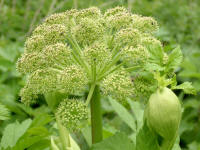
Angelica (Angelica archangelica) - This "herb of the
angels" is a member of the parsley family and is grown extensively in Europe.
The pale green celery-like leaves and stalks are often candied and added to
desserts as a garnish, and used to add a licorice-like flavor to liqueurs and
sweet wines. The plant grows to as much as 8 feet (2.4 m) in height and dies
after blooming, although it can be grown as a perennial if blooming is prevented
by removing the flower stalk. This is one herb that will tolerate shady
locations.
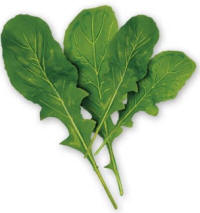 Arugula
(Eruca sativa) - Although the leaves of this plant are usually treated
as a salad green, the spicy, peppery flavor of arugula is also a valued addition
to soups and vegetable dishes. Also known as rocket, it is popular in French
(where it is known as roquette) and Italian (rucola) cooking. It has become near
universally available in the United States in recent years, and is easily
cultivated from seed. Arugula
(Eruca sativa) - Although the leaves of this plant are usually treated
as a salad green, the spicy, peppery flavor of arugula is also a valued addition
to soups and vegetable dishes. Also known as rocket, it is popular in French
(where it is known as roquette) and Italian (rucola) cooking. It has become near
universally available in the United States in recent years, and is easily
cultivated from seed.
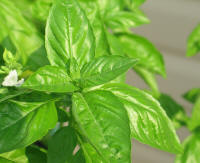 Basil
(Ocimum basilicum) - Also known as sweet basil and the royal herb, the
name is derived from the Greek basilikon meaning royal, and legend has
it that in ancient times only members of the royal class were allowed to harvest
it, preferably with a golden scythe. It is an annual which may be grown as a
perennial if protected from frost, and is a member of the mint family. It does
well as a potted plant on a sunny window sill, and fresh cuttings can be rooted
in a glass of water in just a few days. Hundreds of varieties exist, including
opal basil which is dark purple in color, and cinnamon, lemon, and even
chocolate basil, all of which have a flavor and fragrance reminiscent of their
namesakes. Basil is used the world over and plays a particularly large role in
the cooking of the Mediterranean and Southeast Asia. It should be dried only as
a last resort because it loses most of its flavor, but it freezes exceptionally
well. Perhaps the best way to preserve the taste of basil is to make pesto
Genovese, a puree of fresh basil leaves with olive oil, garlic, pine nuts, and
Parmesan cheese which will keep for several months refrigerated, and almost
indefinitely in the freezer. A dwarf variety (Ocimum minimum) is
considered the sweetest and mildest, and is preferred by the Genovese for making
pesto. Basil
(Ocimum basilicum) - Also known as sweet basil and the royal herb, the
name is derived from the Greek basilikon meaning royal, and legend has
it that in ancient times only members of the royal class were allowed to harvest
it, preferably with a golden scythe. It is an annual which may be grown as a
perennial if protected from frost, and is a member of the mint family. It does
well as a potted plant on a sunny window sill, and fresh cuttings can be rooted
in a glass of water in just a few days. Hundreds of varieties exist, including
opal basil which is dark purple in color, and cinnamon, lemon, and even
chocolate basil, all of which have a flavor and fragrance reminiscent of their
namesakes. Basil is used the world over and plays a particularly large role in
the cooking of the Mediterranean and Southeast Asia. It should be dried only as
a last resort because it loses most of its flavor, but it freezes exceptionally
well. Perhaps the best way to preserve the taste of basil is to make pesto
Genovese, a puree of fresh basil leaves with olive oil, garlic, pine nuts, and
Parmesan cheese which will keep for several months refrigerated, and almost
indefinitely in the freezer. A dwarf variety (Ocimum minimum) is
considered the sweetest and mildest, and is preferred by the Genovese for making
pesto.
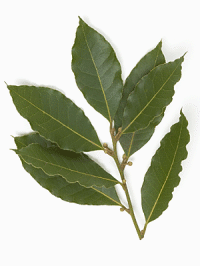 Bay
Leaf (Laurus nobilis) - Also known as laurel leaf and bay laurel, the
leaves of a small evergreen laurel tree native to the Mediterranean have long
been associated with honor, glory, and triumph. Greek athletes were rewarded
with a wreath of laurel leaves, Roman emperors and poets were immortalized in
stone wearing such wreaths, and sayings such as "to earn one's laurels" and
"resting on one's laurels" derive from this plant. They impart a lemon-nutmeg
flavor to foods, and are usually used whole and removed before serving. Two
varieties are commonly available; the shorter, more oval Turkish variety are
much preferred over the longer, narrower California variety. Bay
Leaf (Laurus nobilis) - Also known as laurel leaf and bay laurel, the
leaves of a small evergreen laurel tree native to the Mediterranean have long
been associated with honor, glory, and triumph. Greek athletes were rewarded
with a wreath of laurel leaves, Roman emperors and poets were immortalized in
stone wearing such wreaths, and sayings such as "to earn one's laurels" and
"resting on one's laurels" derive from this plant. They impart a lemon-nutmeg
flavor to foods, and are usually used whole and removed before serving. Two
varieties are commonly available; the shorter, more oval Turkish variety are
much preferred over the longer, narrower California variety.
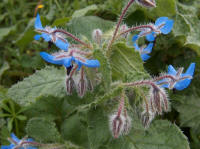 Borage
(Borago officinalis) - A European native, the flowers and hairy leaves
have a flavor reminiscent of cucumber and are used in salads and teas and to
flavor sauces and vegetables. Young leaves can be cooked like spinach, and
should be finely chopped when eaten raw because of their hirsute nature. Borage
(Borago officinalis) - A European native, the flowers and hairy leaves
have a flavor reminiscent of cucumber and are used in salads and teas and to
flavor sauces and vegetables. Young leaves can be cooked like spinach, and
should be finely chopped when eaten raw because of their hirsute nature.
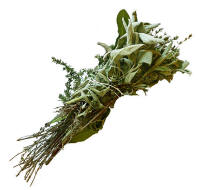 Bouquet
Garni - A bunch of herbs tied together, wrapped in cheesecloth or enclosed in a
tea infuser, and used to flavor soups, stocks, stews, and sauces. Any
combination of herbs and aromatic vegetables may be considered a bouquet garni,
but the classic trio is parsley stems, thyme, and bay leaf. Unlike other herbal
combinations (see Fines Herbes and Herbes de Provence), a bouquet garni is meant
to be removed from the dish before serving. Bouquet
Garni - A bunch of herbs tied together, wrapped in cheesecloth or enclosed in a
tea infuser, and used to flavor soups, stocks, stews, and sauces. Any
combination of herbs and aromatic vegetables may be considered a bouquet garni,
but the classic trio is parsley stems, thyme, and bay leaf. Unlike other herbal
combinations (see Fines Herbes and Herbes de Provence), a bouquet garni is meant
to be removed from the dish before serving.
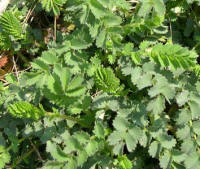 Burnet
(Sanguisorba minor) - Also known as salad burnet, the leaves of this
compact evergreen perennial are often added to salads in Italy, where some say
that a salad without burnet is like love without a woman. The small, saw-toothed
leaves have a nutty, cucumber-like flavor and may be used in soups or cooked
like spinach. Burnet
(Sanguisorba minor) - Also known as salad burnet, the leaves of this
compact evergreen perennial are often added to salads in Italy, where some say
that a salad without burnet is like love without a woman. The small, saw-toothed
leaves have a nutty, cucumber-like flavor and may be used in soups or cooked
like spinach.
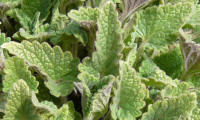 Catnip
(Nepeta cataria) - Prized for centuries for its minty, camphorous
aroma, catnip isn't as popular in the kitchen as it once was, although it is
still used in Italy to season soups, salads, vegetables, and egg dishes. The
plants are easy to grow in partial shade to full sun, and are readily available
through commercial nurseries. Catnip
(Nepeta cataria) - Prized for centuries for its minty, camphorous
aroma, catnip isn't as popular in the kitchen as it once was, although it is
still used in Italy to season soups, salads, vegetables, and egg dishes. The
plants are easy to grow in partial shade to full sun, and are readily available
through commercial nurseries.
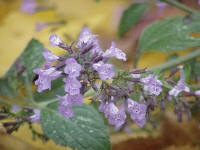 Calamint
(genus Calamintha) - The pleasantly minty, thyme-like flavor and aroma
of these members of the mint have are used to flavor vegetable and mushroom
dishes in Tuscany, Sicily, and Sardinia, where the dried leaves are also used to
brew teas. They are easy to grow, and like most natives of the Mediterranean,
they prefer full sun and sandy soil. Calamint
(genus Calamintha) - The pleasantly minty, thyme-like flavor and aroma
of these members of the mint have are used to flavor vegetable and mushroom
dishes in Tuscany, Sicily, and Sardinia, where the dried leaves are also used to
brew teas. They are easy to grow, and like most natives of the Mediterranean,
they prefer full sun and sandy soil.
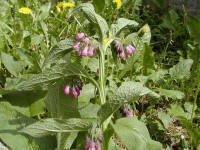 Comfrey
(Symphitum officinale) - Comfrey isn't found in many kitchens these
days, but it was valued in the Middle Ages as much for its culinary uses as its
supposed ability to cure a variety of ailments. The large hairy leaves may be
added to salads and sauces, or battered and deep-fried. Comfrey
(Symphitum officinale) - Comfrey isn't found in many kitchens these
days, but it was valued in the Middle Ages as much for its culinary uses as its
supposed ability to cure a variety of ailments. The large hairy leaves may be
added to salads and sauces, or battered and deep-fried.
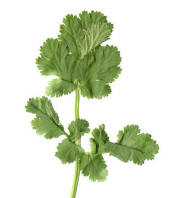 Celery
Leaves (Apium graveolens) - Although the stalks of the celery plant are
usually treated as a vegetable, the leaves of the same plant are often used as
an herb and form the foundation of many traditional dishes, such as Belgium's
anguilles au vert (eels in green sauce). Celery leaves have the rare
ability among herbs to retain much of their flavor even after prolonged cooking,
and are therefore frequently added to soups, stews, and bean dishes. Celery
Leaves (Apium graveolens) - Although the stalks of the celery plant are
usually treated as a vegetable, the leaves of the same plant are often used as
an herb and form the foundation of many traditional dishes, such as Belgium's
anguilles au vert (eels in green sauce). Celery leaves have the rare
ability among herbs to retain much of their flavor even after prolonged cooking,
and are therefore frequently added to soups, stews, and bean dishes.
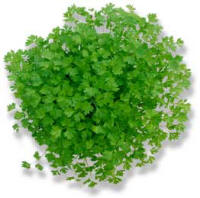 Chervil
(Anthriscus cerefolium) - Also called cicily or sweet cicily, chervil
has dark green, curly leaves and is a member of the parsley family. It is a
self-sowing annual that prefers a little shade. Its flavor is like parsley with
a hint of anise. Chervil
(Anthriscus cerefolium) - Also called cicily or sweet cicily, chervil
has dark green, curly leaves and is a member of the parsley family. It is a
self-sowing annual that prefers a little shade. Its flavor is like parsley with
a hint of anise.
 Chives
(Allium schoenprasum) - Like all members of the onion family, chives
have long, hollow leaves with a mild, onion-like flavor. Though they are
available fresh year round in most parts of the United States, the perennial
bulbs are easy to grow just about anywhere. Chives
(Allium schoenprasum) - Like all members of the onion family, chives
have long, hollow leaves with a mild, onion-like flavor. Though they are
available fresh year round in most parts of the United States, the perennial
bulbs are easy to grow just about anywhere.
 Cilantro
(Coriandrum sativum) - Know to Americans by its Spanish name, the rest
of the English speaking world knows cilantro as coriander or Chinese parsley.
The same plant that produces coriander seeds (a spice) also produces the flat
leaves that look almost exactly like flat-leaf parsley, but with a flavor that
can't be mistaken-some people describe it as "soapy." The leaves, stems, and
roots are often used in Caribbean, Latin American, and Asian cooking, and only
the fresh herb should be used as it loses all its flavor when dried. Easily
grown from seed, buy seeds or plants that have been bred for their foliage
rather than their seeds or your plants will bolt to seed and produce very few
leaves. Cilantro
(Coriandrum sativum) - Know to Americans by its Spanish name, the rest
of the English speaking world knows cilantro as coriander or Chinese parsley.
The same plant that produces coriander seeds (a spice) also produces the flat
leaves that look almost exactly like flat-leaf parsley, but with a flavor that
can't be mistaken-some people describe it as "soapy." The leaves, stems, and
roots are often used in Caribbean, Latin American, and Asian cooking, and only
the fresh herb should be used as it loses all its flavor when dried. Easily
grown from seed, buy seeds or plants that have been bred for their foliage
rather than their seeds or your plants will bolt to seed and produce very few
leaves.
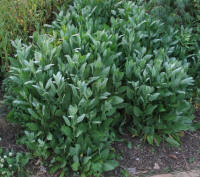 Costmary
(Chrysanthemum balsamita) - Also known as alecost because it was used
in making ale, the silvery leaves of costmary have a strong lemony, minty aroma.
They are used-sparingly-in soups, stews, stuffings, and salads. The 4-foot-tall
(1.2 m) perennial isn't particular with regard to soil, but it does prefer full
sun. Costmary
(Chrysanthemum balsamita) - Also known as alecost because it was used
in making ale, the silvery leaves of costmary have a strong lemony, minty aroma.
They are used-sparingly-in soups, stews, stuffings, and salads. The 4-foot-tall
(1.2 m) perennial isn't particular with regard to soil, but it does prefer full
sun.
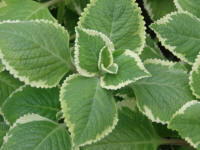 Cuban
Oregano (Plectranthus amboinicus) - Even though this plant is probably
native to India, it also goes by the names Spanish thyme and Indian borage. The
thick, fleshy, fuzzy leaves are usually variegated and have a strong
oregano-like flavor with overtones of sage. The plant is extremely tender so
must be brought indoors during the winter, and like the coleus species which it
resembles, it does very well in containers. Cuban
Oregano (Plectranthus amboinicus) - Even though this plant is probably
native to India, it also goes by the names Spanish thyme and Indian borage. The
thick, fleshy, fuzzy leaves are usually variegated and have a strong
oregano-like flavor with overtones of sage. The plant is extremely tender so
must be brought indoors during the winter, and like the coleus species which it
resembles, it does very well in containers.
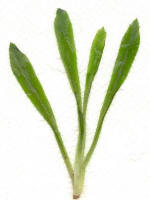 Culantro
(Eryngium foetidum) - This herb, popular in the Caribbean and Central
America, is also known as recao in Spanish, false cilantro, spirit
weed, and Mexican coriander. It has long, spear-shaped leaves with jagged edges
and tastes very much like cilantro, only stronger and more bitter. Culantro
(Eryngium foetidum) - This herb, popular in the Caribbean and Central
America, is also known as recao in Spanish, false cilantro, spirit
weed, and Mexican coriander. It has long, spear-shaped leaves with jagged edges
and tastes very much like cilantro, only stronger and more bitter.
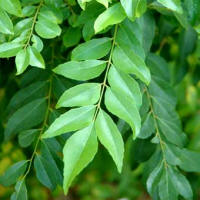 Curry
Leaf (Chalcas koenigii) - The leaves of the curry plant resemble small,
shiny bay laurel leaves and have a mild flavor reminiscent of lemon and lime.
Widely used in India where they are known as meetha neem or kari
patta, they are available both fresh and dried in Indian specialty shops.
The dried version may be substituted for the fresh, but the flavor is far
inferior. Curry
Leaf (Chalcas koenigii) - The leaves of the curry plant resemble small,
shiny bay laurel leaves and have a mild flavor reminiscent of lemon and lime.
Widely used in India where they are known as meetha neem or kari
patta, they are available both fresh and dried in Indian specialty shops.
The dried version may be substituted for the fresh, but the flavor is far
inferior.
 Dill
(Anethum graveolens) - The feathery leaves of this annual plant lose
their anise-like flavor rapidly when cooked, so use them raw in salads or as a
garnish, or add them immediately before serving if using them in a warm dish.
The seeds of the same plant which self-sows readily and grows to a height of 3
to 4 feet (1.5 m) are used in pickling and give the "dill" to dill pickles. Dill
(Anethum graveolens) - The feathery leaves of this annual plant lose
their anise-like flavor rapidly when cooked, so use them raw in salads or as a
garnish, or add them immediately before serving if using them in a warm dish.
The seeds of the same plant which self-sows readily and grows to a height of 3
to 4 feet (1.5 m) are used in pickling and give the "dill" to dill pickles.
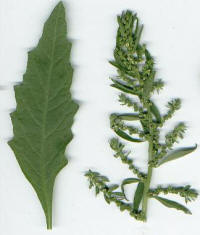 Epazote
(Dysphania ambrosiodes) - Also know as wormweed and stinkweed for its
strong, kerosene-like aroma, it is used fresh in Mexican and Southwest American
cooking, and dried in beverages. It is believed to have carminative powers,
meaning that it helps to expel gasses from the body, and is therefore often
added to bean dishes. Epazote
(Dysphania ambrosiodes) - Also know as wormweed and stinkweed for its
strong, kerosene-like aroma, it is used fresh in Mexican and Southwest American
cooking, and dried in beverages. It is believed to have carminative powers,
meaning that it helps to expel gasses from the body, and is therefore often
added to bean dishes.
 Fennel
Leaves (Foeniculum genus) - The fine, feathery leaves of the fennel
plant resemble those of dill, and can be used in much the same manner even
though the plant is cultivated primarily for its seeds and edible bulb. All
parts of the plant have a pleasant, licorice-like flavor, and the leaves are a
welcome addition to salads, soups, and fish dishes. Fennel
Leaves (Foeniculum genus) - The fine, feathery leaves of the fennel
plant resemble those of dill, and can be used in much the same manner even
though the plant is cultivated primarily for its seeds and edible bulb. All
parts of the plant have a pleasant, licorice-like flavor, and the leaves are a
welcome addition to salads, soups, and fish dishes.
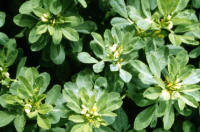 Fenugreek
(Trigonella foenum-graecum) - Although the seeds are usually used as a
spice, the leaves of the fenugreek plant may be eaten raw in salads and are
prized for their celery-like flavor. Fenugreek
(Trigonella foenum-graecum) - Although the seeds are usually used as a
spice, the leaves of the fenugreek plant may be eaten raw in salads and are
prized for their celery-like flavor.
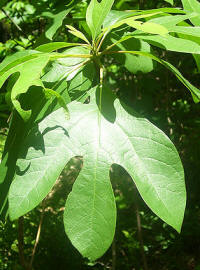 File
Powder (Sassafras albidum) - The ground leaves of the sassafras tree, a
member of the laurel family, are also known as gumbo file (pronounced FEE-lay or
fee-LAY). Used by the Choctaw Indians and in Cajun and Louisiana Creole cooking,
they act as a seasoning and thickener. The bark of the roots of the same plant
used to be used to make root beer, and the flavor of the ground leaves is
faintly reminiscent of this old-fashioned favorite. File
Powder (Sassafras albidum) - The ground leaves of the sassafras tree, a
member of the laurel family, are also known as gumbo file (pronounced FEE-lay or
fee-LAY). Used by the Choctaw Indians and in Cajun and Louisiana Creole cooking,
they act as a seasoning and thickener. The bark of the roots of the same plant
used to be used to make root beer, and the flavor of the ground leaves is
faintly reminiscent of this old-fashioned favorite.
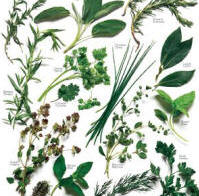 Fines
Herbes - A mixture of chopped fresh herbs, the classic combination is chervil,
chives, tarragon, and parsley, although a variety of other herbs may be
included. Unlike a bouquet garni, fines herbes lose their flavor quickly and are
best added to a dish shortly before it is served. The term is also used to
describe finely chopped parsley and refers not so much to the herb as the degree
(or "fineness") to which it is chopped. Fines
Herbes - A mixture of chopped fresh herbs, the classic combination is chervil,
chives, tarragon, and parsley, although a variety of other herbs may be
included. Unlike a bouquet garni, fines herbes lose their flavor quickly and are
best added to a dish shortly before it is served. The term is also used to
describe finely chopped parsley and refers not so much to the herb as the degree
(or "fineness") to which it is chopped.
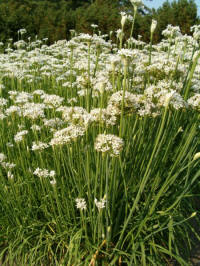 Garlic
Chives (Allium tuberosum) - Similar in appearance to regular chives,
garlic chives have longer, wider, and flatter leaves with a pronounced garlic
flavor and aroma. Also called Chinese chives or ku chai, they may be used raw or
cooked. Like regular chives, the flowers may also be eaten and make an
attractive and flavorful garnish. Garlic
Chives (Allium tuberosum) - Similar in appearance to regular chives,
garlic chives have longer, wider, and flatter leaves with a pronounced garlic
flavor and aroma. Also called Chinese chives or ku chai, they may be used raw or
cooked. Like regular chives, the flowers may also be eaten and make an
attractive and flavorful garnish.
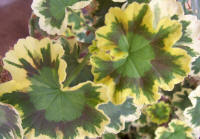 Geranium
(genus Pelargonium) - The leaves of various scented geraniums may be
used to flavor baked goods, jellies, candies, and teas. Available flavors
include rose, lemon, lime, orange, apple, and mint. They are tender perennials
and do well in containers. Geranium
(genus Pelargonium) - The leaves of various scented geraniums may be
used to flavor baked goods, jellies, candies, and teas. Available flavors
include rose, lemon, lime, orange, apple, and mint. They are tender perennials
and do well in containers.
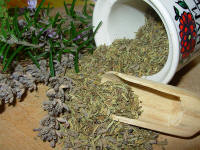 Herbes
de Provence - More of a marketing strategy than a classical French concept,
herbes de Provence is a mixture of herbs said to be representative of the herbs
used in southern France. The mixture usually contains basil, rosemary, lavender,
marjoram, sage, thyme, and fennel seeds. Herbes
de Provence - More of a marketing strategy than a classical French concept,
herbes de Provence is a mixture of herbs said to be representative of the herbs
used in southern France. The mixture usually contains basil, rosemary, lavender,
marjoram, sage, thyme, and fennel seeds.
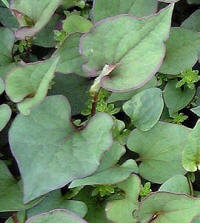 Houttuynia
(Houttuynia cordata) - The leaves of this Japanese native are used to
flavor soups, fish, and pork dishes in Japan and throughout Southeast Asia. It
has a strong flavor similar to cilantro with distinctly fishy undertones, and is
called "fish mint" by the Vietnamese. It requires lots of moisture and prefers
to be planted at the edge of a pond or stream. Houttuynia
(Houttuynia cordata) - The leaves of this Japanese native are used to
flavor soups, fish, and pork dishes in Japan and throughout Southeast Asia. It
has a strong flavor similar to cilantro with distinctly fishy undertones, and is
called "fish mint" by the Vietnamese. It requires lots of moisture and prefers
to be planted at the edge of a pond or stream.
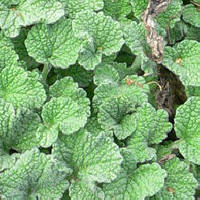 Horehound
(Marrubium vulgare) - The fuzzy leaves of this member of the mint
family yield a bitter extract that is used in candy, throat lozenges, and cough
syrup. The three-foot (1 m) plant is a hardy perennial that thrives in poor
soil. Horehound
(Marrubium vulgare) - The fuzzy leaves of this member of the mint
family yield a bitter extract that is used in candy, throat lozenges, and cough
syrup. The three-foot (1 m) plant is a hardy perennial that thrives in poor
soil.
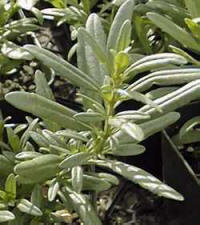 Hyssop
(Hyssopus officinalis) - The dark green leaves of this hardy perennial
have a strong mint and licorice flavor and can be used to flavor salads, fruit
dishes, soups, and stews. It is also a flavor component in some liqueurs. Hyssop
(Hyssopus officinalis) - The dark green leaves of this hardy perennial
have a strong mint and licorice flavor and can be used to flavor salads, fruit
dishes, soups, and stews. It is also a flavor component in some liqueurs.
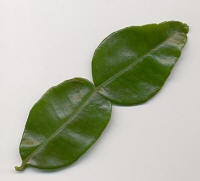 Kaffir
Lime (Citrus hysterix) - The leaves and dried skin of the fruit of this
citrus are used in Thai, Indonesian, and other Southeast Asian cuisines. The
leaves have a unique figure-eight configuration resembling two leaves joined end
to end, and can be found fresh and dried in many Asian specialty shops. Kaffir
Lime (Citrus hysterix) - The leaves and dried skin of the fruit of this
citrus are used in Thai, Indonesian, and other Southeast Asian cuisines. The
leaves have a unique figure-eight configuration resembling two leaves joined end
to end, and can be found fresh and dried in many Asian specialty shops.
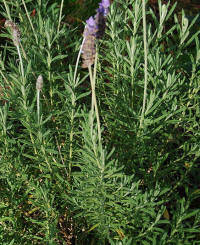 Lavender
(Lavendula angustifolia) - The leaves of this herb have a bitter,
pine-like flavor and aroma and are best used sparingly in soups and stews,
although the flowers have a more subtle, slightly lemony flavor. It is a hardy
evergreen perennial that prefers dry alkaline soil and full sun. Lavender
(Lavendula angustifolia) - The leaves of this herb have a bitter,
pine-like flavor and aroma and are best used sparingly in soups and stews,
although the flowers have a more subtle, slightly lemony flavor. It is a hardy
evergreen perennial that prefers dry alkaline soil and full sun.
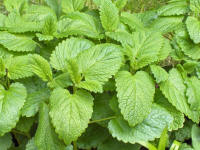 Lemon
Balm (Melissa officinalis) - A small perennial herb that will grow in
just about any soil in full sun, the leaves have a strong lemony flavor that is
widely used in teas and salads and as a garnish for fruit salads and fruit
soups. It can also be used with fish and poultry. Lemon
Balm (Melissa officinalis) - A small perennial herb that will grow in
just about any soil in full sun, the leaves have a strong lemony flavor that is
widely used in teas and salads and as a garnish for fruit salads and fruit
soups. It can also be used with fish and poultry.
 Lemon
Grass (Cymbopogon citratus) - The lower stalks of this tropical grass
are highly valued for their fresh lemony flavor in Southeast Asia. Fresh lemon
grass has become widely available in the USA in the past few years, and
freeze-dried, powdered, and pureed versions are also available. For the best
flavor, use only fresh lemon grass. Although only the most tender central
portions of the stalk are used, they are nonetheless woody and are usually
chopped very finely or cooked whole and removed from the dish before serving.
Store-bought fresh stalk may often be rooted in a glass of water before
transplanting to the garden where they will grow and multiply rapidly even in
moderate climates, although the plant is tender and will not survive frost
conditions. Use it for a taste of authenticity in almost all Southeast Asian
soups, curries, and stir-fried dishes. Lemon
Grass (Cymbopogon citratus) - The lower stalks of this tropical grass
are highly valued for their fresh lemony flavor in Southeast Asia. Fresh lemon
grass has become widely available in the USA in the past few years, and
freeze-dried, powdered, and pureed versions are also available. For the best
flavor, use only fresh lemon grass. Although only the most tender central
portions of the stalk are used, they are nonetheless woody and are usually
chopped very finely or cooked whole and removed from the dish before serving.
Store-bought fresh stalk may often be rooted in a glass of water before
transplanting to the garden where they will grow and multiply rapidly even in
moderate climates, although the plant is tender and will not survive frost
conditions. Use it for a taste of authenticity in almost all Southeast Asian
soups, curries, and stir-fried dishes.
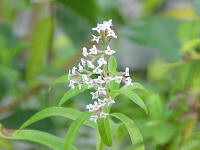 Lemon
Verbena (Aloysia citriodora) - Another lemon-scented herb often used in
teas and sachets, the overpowering flavor of this herb is best used in
moderation in salads and desserts. Also called simply verbena, it is a tall,
tender perennial that does well in containers. Lemon
Verbena (Aloysia citriodora) - Another lemon-scented herb often used in
teas and sachets, the overpowering flavor of this herb is best used in
moderation in salads and desserts. Also called simply verbena, it is a tall,
tender perennial that does well in containers.
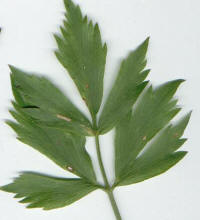 Lovage
(Levisticum officinale) - The French call it celeri batard
(false celery) because of its many similarities to celery, and it's also known
as sea parsley, smallage, smellage, and wild parsley. This tall (up to 8 feet,
2.4 m) perennial has an extremely strong flavor of celery and may be used as a
celery substitute. The leaves may be added to salads and stews, and the slender
hollow stalks may be braised like celery or candied like angelica. This is also
the plant that provides us with the spice celery seed. Lovage
(Levisticum officinale) - The French call it celeri batard
(false celery) because of its many similarities to celery, and it's also known
as sea parsley, smallage, smellage, and wild parsley. This tall (up to 8 feet,
2.4 m) perennial has an extremely strong flavor of celery and may be used as a
celery substitute. The leaves may be added to salads and stews, and the slender
hollow stalks may be braised like celery or candied like angelica. This is also
the plant that provides us with the spice celery seed.
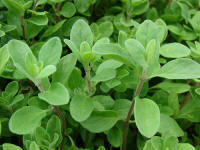 Marjoram
(Origanum marjorana) - Also called sweet marjoram, it is usually
considered sweeter and milder than its close relative oregano-the two plants are
very similar and often confused. Native to the Mediterranean region, marjoram is
usually used to flavor meats and stews, and has a particular affinity for lamb
and veal. Its flavor dissipates quickly when added to hot foods, so add it at
the end of cooking for best results. Marjoram
(Origanum marjorana) - Also called sweet marjoram, it is usually
considered sweeter and milder than its close relative oregano-the two plants are
very similar and often confused. Native to the Mediterranean region, marjoram is
usually used to flavor meats and stews, and has a particular affinity for lamb
and veal. Its flavor dissipates quickly when added to hot foods, so add it at
the end of cooking for best results.
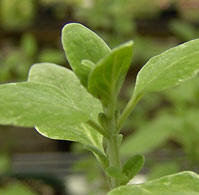 Micromeria
(genus Micromeria) - The leaves of this genus have flavors and aromas
similar to mint, thyme, and savory. Often called Emperor mint, it is used in
Italy and the Adriatic region to flavor soups, salads, and egg dishes, and in
stuffing for chicken and wild game. Finely chopped leaves are often added to
pasta sauces and sprinkled over meats before grilling. They prefer full sun and
sandy soil. Micromeria
(genus Micromeria) - The leaves of this genus have flavors and aromas
similar to mint, thyme, and savory. Often called Emperor mint, it is used in
Italy and the Adriatic region to flavor soups, salads, and egg dishes, and in
stuffing for chicken and wild game. Finely chopped leaves are often added to
pasta sauces and sprinkled over meats before grilling. They prefer full sun and
sandy soil.
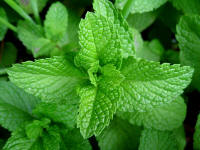 Mint
(genus Mentha) - According to Greek mythology, the nymph Mentha angered
Pluto's wife Persephone who turned her into the fragrant herb. In addition to
peppermint and spearmint, dozens of different varieties of mint are available to
the home gardener. Most of these have undertones of other foods such as apple,
lemon, orange, pineapple, and even chocolate. Fresh mint is often used in
Mediterranean, Middle Eastern, and Southeast Asian cooking, and can also be used
to make teas and infusions. Stalks of fresh mint will root readily in a glass of
water, and it grows so rampantly that it might be a good idea to get permission
from your neighbors before planting any in your own yard. Mint
(genus Mentha) - According to Greek mythology, the nymph Mentha angered
Pluto's wife Persephone who turned her into the fragrant herb. In addition to
peppermint and spearmint, dozens of different varieties of mint are available to
the home gardener. Most of these have undertones of other foods such as apple,
lemon, orange, pineapple, and even chocolate. Fresh mint is often used in
Mediterranean, Middle Eastern, and Southeast Asian cooking, and can also be used
to make teas and infusions. Stalks of fresh mint will root readily in a glass of
water, and it grows so rampantly that it might be a good idea to get permission
from your neighbors before planting any in your own yard.
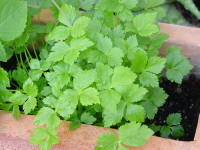 Mitsuba
(Cryptotaenia japonica) - Also known as trefoil, Japanese parsley, and
Japanese chervil, mitsuba is highly valued in Japanese cooking for its subtle
flavor with hints of celery, sorrel, and cloves. It is used to season mushroom
and egg dishes, and is often battered and fried for tempura. The compact
perennial is native to the woodlands of Japan and prefers a shady location. Mitsuba
(Cryptotaenia japonica) - Also known as trefoil, Japanese parsley, and
Japanese chervil, mitsuba is highly valued in Japanese cooking for its subtle
flavor with hints of celery, sorrel, and cloves. It is used to season mushroom
and egg dishes, and is often battered and fried for tempura. The compact
perennial is native to the woodlands of Japan and prefers a shady location.
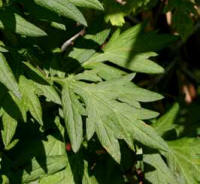 Mugwort
(Artemisia vulgaris) - This close relative of tarragon and wormwood
grows throughout North and South America, Europe, and Asia. Its aroma is a
subtle mixture of juniper, mint, and pepper, and it has a similar taste. It was
very popular during the 18th and 19th centuries and was used to add a bitter
flavor to beer, the role played by hops today. It is used in marinades,
stuffings, and soups, and in Japan, where it is known as yomogi, it
flavors rice cakes and soba noodles. The small perennial is easy to grow in the
home herb garden if provided full sun and a rich soil. Mugwort
(Artemisia vulgaris) - This close relative of tarragon and wormwood
grows throughout North and South America, Europe, and Asia. Its aroma is a
subtle mixture of juniper, mint, and pepper, and it has a similar taste. It was
very popular during the 18th and 19th centuries and was used to add a bitter
flavor to beer, the role played by hops today. It is used in marinades,
stuffings, and soups, and in Japan, where it is known as yomogi, it
flavors rice cakes and soba noodles. The small perennial is easy to grow in the
home herb garden if provided full sun and a rich soil.
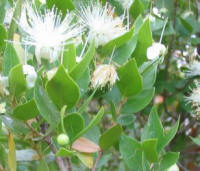 Myrtle
(Myrtus communis) - All parts of this native of the Mediterranean
region have a pleasant aroma which evokes juniper, rosemary, and allspice. It is
used to flavor meats, and is especially effective when paired with wild game.
Its popularity faded after the Middle Ages with the introduction of herbs and
spices imported from the Orient, but its leaves are still used in Italy as a
wrapping for cheese. Grow this tender perennial in partial shade, and protect it
from freezing temperatures in cooler climates. Myrtle
(Myrtus communis) - All parts of this native of the Mediterranean
region have a pleasant aroma which evokes juniper, rosemary, and allspice. It is
used to flavor meats, and is especially effective when paired with wild game.
Its popularity faded after the Middle Ages with the introduction of herbs and
spices imported from the Orient, but its leaves are still used in Italy as a
wrapping for cheese. Grow this tender perennial in partial shade, and protect it
from freezing temperatures in cooler climates.
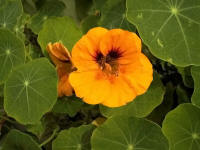 Nasturtium
(genus Tropaeolum) - All parts of the members of this genus are edible
except for the roots. The leaves and stems have a peppery flavor and may be used
as a substitute for watercress. The beautiful yellow and orange flowers also
have a peppery flavor and make an eye-catching addition to salads. They can also
be finely chopped and used to flavor butter and sauces. The immature flower buds
can be pickled and used like capers. Nasturtium
(genus Tropaeolum) - All parts of the members of this genus are edible
except for the roots. The leaves and stems have a peppery flavor and may be used
as a substitute for watercress. The beautiful yellow and orange flowers also
have a peppery flavor and make an eye-catching addition to salads. They can also
be finely chopped and used to flavor butter and sauces. The immature flower buds
can be pickled and used like capers.
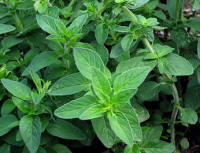 Oregano
(Origanum vulgare) - Greek for "joy of the mountains," oregano was
virtually unknown in the United States until soldiers returning from Italy at
the end of World War II raved about it. Also known as wild marjoram, oregano can
be used interchangeably with marjoram even though it is slightly more pungent
and bitter. Oregano
(Origanum vulgare) - Greek for "joy of the mountains," oregano was
virtually unknown in the United States until soldiers returning from Italy at
the end of World War II raved about it. Also known as wild marjoram, oregano can
be used interchangeably with marjoram even though it is slightly more pungent
and bitter.
_leaves.JPG) Pandan
(Pandanus amaryllifolius) - The sword-like leaves of the pandan tree
have a pleasant grassy, floral aroma and are used primarily to wrap foods for
cooking in southern Asia. They are often available in Asian markets and must be
pounded before use to release their flavor. They are also used to lend a
delicate fragrance to rice dishes. Pandan
(Pandanus amaryllifolius) - The sword-like leaves of the pandan tree
have a pleasant grassy, floral aroma and are used primarily to wrap foods for
cooking in southern Asia. They are often available in Asian markets and must be
pounded before use to release their flavor. They are also used to lend a
delicate fragrance to rice dishes.
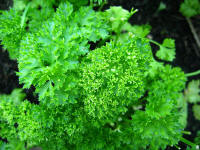 Parsley
(genus Petroselium) - Although there are at least three dozen varieties
of parsley, the ones we encounter in the kitchen are usually the curly parsley (P.
crispum) and the flat-leaf parsley (P. hortense or P.
neopolitanum), also known as Italian parsley. Classified as a biennial,
parsley grows during its first season, then flowers and dies during its second
season. However, it may be grown as a hardy evergreen perennial if the flower
stalk is removed before the plant comes into bloom-I have had a few plants of
both curly and flat-leaf varieties survive in my garden for several years. Even
though most pundits claim that the flat-leaf variety has a stronger flavor, I
can't say that my experience bears this out. Many professional chefs buy only
the curly variety because it can be used both for cooking and garnishing. The
stems have even stronger flavor than the leaves and are used in bouquets garnies
and to flavor roasts and large cuts of meat. The leaves, stems, and roots of the
plant are all rich in vitamins A and C. Fresh parsley is now available nearly
everywhere, and should always be used in place of the dried herb which has
virtually no flavor and bears little resemblance to the real thing. Parsley
(genus Petroselium) - Although there are at least three dozen varieties
of parsley, the ones we encounter in the kitchen are usually the curly parsley (P.
crispum) and the flat-leaf parsley (P. hortense or P.
neopolitanum), also known as Italian parsley. Classified as a biennial,
parsley grows during its first season, then flowers and dies during its second
season. However, it may be grown as a hardy evergreen perennial if the flower
stalk is removed before the plant comes into bloom-I have had a few plants of
both curly and flat-leaf varieties survive in my garden for several years. Even
though most pundits claim that the flat-leaf variety has a stronger flavor, I
can't say that my experience bears this out. Many professional chefs buy only
the curly variety because it can be used both for cooking and garnishing. The
stems have even stronger flavor than the leaves and are used in bouquets garnies
and to flavor roasts and large cuts of meat. The leaves, stems, and roots of the
plant are all rich in vitamins A and C. Fresh parsley is now available nearly
everywhere, and should always be used in place of the dried herb which has
virtually no flavor and bears little resemblance to the real thing.
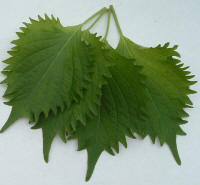 Perilla
(Perilla frutescens) - Better known by its Japanese name shiso,
the leaves of this annual herb are prized in the cooking of Japan, Korea, and
Indochina. Two varieties are available. The leaves of green perilla have frilly
edges and a flavor reminiscent of cinnamon, cumin, and citrus. They are served
with sushi and sashimi-they are said to combat parasites found in raw fish-and
are featured in many rice and noodle dishes. Red perilla is milder in flavor and
bears little resemblance to the green variety, with its jagged, purple leaves.
Its primary use in Japanese cuisine is in pickles and as a coloring agent. Perilla
(Perilla frutescens) - Better known by its Japanese name shiso,
the leaves of this annual herb are prized in the cooking of Japan, Korea, and
Indochina. Two varieties are available. The leaves of green perilla have frilly
edges and a flavor reminiscent of cinnamon, cumin, and citrus. They are served
with sushi and sashimi-they are said to combat parasites found in raw fish-and
are featured in many rice and noodle dishes. Red perilla is milder in flavor and
bears little resemblance to the green variety, with its jagged, purple leaves.
Its primary use in Japanese cuisine is in pickles and as a coloring agent.
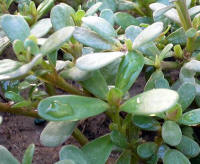 Purslane
(Portulaca oleracea) - The odd looking, round, fleshy leaves of
purslane are often added to salads in India and the Middle East, and it is
featured in the Lebanese salad fattoush along with parsley and mint. It has a
mild lemony flavor and is valued primarily for its crisp, crunchy texture. It is
eaten both raw and cooked. Purslane
(Portulaca oleracea) - The odd looking, round, fleshy leaves of
purslane are often added to salads in India and the Middle East, and it is
featured in the Lebanese salad fattoush along with parsley and mint. It has a
mild lemony flavor and is valued primarily for its crisp, crunchy texture. It is
eaten both raw and cooked.
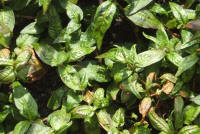 Rau
Ram (Persicaria odorata) - This herb goes by many names, including
Vietnamese cilantro, Vietnamese mint, and laksa leaf. It is extremely popular in
the cooking of Vietnam and Southeast Asia, and is frequently included in the
platter of fresh herbs served with most Vietnamese meals. It is immediately
recognizable due to the purple chevron on the elongated leaves. With a flavor
similar to cilantro and citrus, it is used in all types of dishes and is valued
because it retains its flavor after cooking better than cilantro does. Cuttings
are easily rooted, and this tender perennial prefers wet feet and full sun. Rau
Ram (Persicaria odorata) - This herb goes by many names, including
Vietnamese cilantro, Vietnamese mint, and laksa leaf. It is extremely popular in
the cooking of Vietnam and Southeast Asia, and is frequently included in the
platter of fresh herbs served with most Vietnamese meals. It is immediately
recognizable due to the purple chevron on the elongated leaves. With a flavor
similar to cilantro and citrus, it is used in all types of dishes and is valued
because it retains its flavor after cooking better than cilantro does. Cuttings
are easily rooted, and this tender perennial prefers wet feet and full sun.
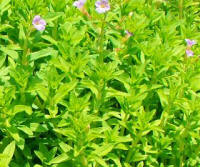 Rice
Paddy Herb (Limnophilia aromatica) - The shoots and leaves of this
tender perennial are used extensively in Vietnamese cooking where it is known as
rau om and rau ngo. The delicate flavor has notes of citrus and
cumin, and is used to season fish, soups, and vegetables. It is a challenge to
grow because it prefers a location by a stream or pond, but it is becoming
increasingly available in American supermarkets, especially in locations with
significant Vietnamese populations. Rice
Paddy Herb (Limnophilia aromatica) - The shoots and leaves of this
tender perennial are used extensively in Vietnamese cooking where it is known as
rau om and rau ngo. The delicate flavor has notes of citrus and
cumin, and is used to season fish, soups, and vegetables. It is a challenge to
grow because it prefers a location by a stream or pond, but it is becoming
increasingly available in American supermarkets, especially in locations with
significant Vietnamese populations.
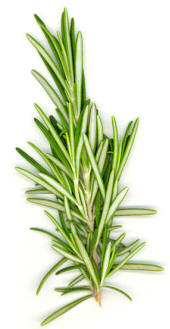 Rosemary
(Rosmarinus officinalis) - One of the most versatile of all herbs, this
Mediterranean native complements just about everything from meat, poultry, and
seafood to fruit, eggs, and baked goods. The long, slender, silver-green leaves
have a sharp pungency reminiscent of pine and citrus. It is one of the few herbs
that retains much of its characteristic flavor when dried, and should be used
sparingly whether fresh or dried. An evergreen perennial that is available in a
variety of cultivars ranging from miniature, ground-cover, and shrub varieties,
it grows in just about any soil in full or partial sun. Use the fresh twigs to
flavor grilled meats by throwing them directly on the hot embers, and peel the
leaves from the stiff branches to use them as skewers for brochettes of seafood
and fresh fruit. Rosemary
(Rosmarinus officinalis) - One of the most versatile of all herbs, this
Mediterranean native complements just about everything from meat, poultry, and
seafood to fruit, eggs, and baked goods. The long, slender, silver-green leaves
have a sharp pungency reminiscent of pine and citrus. It is one of the few herbs
that retains much of its characteristic flavor when dried, and should be used
sparingly whether fresh or dried. An evergreen perennial that is available in a
variety of cultivars ranging from miniature, ground-cover, and shrub varieties,
it grows in just about any soil in full or partial sun. Use the fresh twigs to
flavor grilled meats by throwing them directly on the hot embers, and peel the
leaves from the stiff branches to use them as skewers for brochettes of seafood
and fresh fruit.
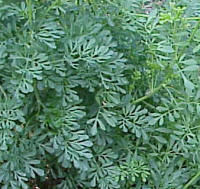 Rue
(Ruta graveolens) - The grey-green leaves of this hardy perennial are
often suggested for salads, sandwiches, and fruit desserts, but many people
experience an allergic reaction similar to that provoked by poison ivy, so I
suggest you leave this out of your culinary herb garden. Rue
(Ruta graveolens) - The grey-green leaves of this hardy perennial are
often suggested for salads, sandwiches, and fruit desserts, but many people
experience an allergic reaction similar to that provoked by poison ivy, so I
suggest you leave this out of your culinary herb garden.
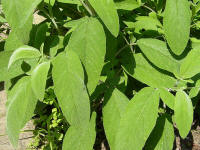 Sage
(Salvia officinalis) - One of the most popular of culinary herbs, the
fuzzy, grey-green leaves of this perennial Mediterranean native can be used
fresh, dried and crumbled, or dried and ground (aka "rubbed"). Although it loses
much of its potency when dried, both the dried and fresh should be used
sparingly because the powerful musty, minty flavor can be overpowering. Many
species of the genus Salvia are used as ornamental plants and the home gardener
should be aware that not every plant labeled "sage" is suitable for culinary
use. Sage
(Salvia officinalis) - One of the most popular of culinary herbs, the
fuzzy, grey-green leaves of this perennial Mediterranean native can be used
fresh, dried and crumbled, or dried and ground (aka "rubbed"). Although it loses
much of its potency when dried, both the dried and fresh should be used
sparingly because the powerful musty, minty flavor can be overpowering. Many
species of the genus Salvia are used as ornamental plants and the home gardener
should be aware that not every plant labeled "sage" is suitable for culinary
use.
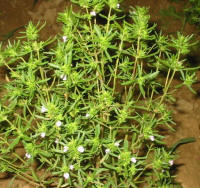 Savory,
Summer (Satureja hortensis) - This annual herb with needlelike leaves
has a pungent flavor reminiscent of thyme and rosemary. It is more subtle than
its cousin winter savory, but should still be used sparingly. It requires full
sun and well drained soil. Savory,
Summer (Satureja hortensis) - This annual herb with needlelike leaves
has a pungent flavor reminiscent of thyme and rosemary. It is more subtle than
its cousin winter savory, but should still be used sparingly. It requires full
sun and well drained soil.
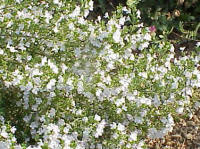 Savory,
Winter (Satureja montana) - The perennial version of summer savory,
winter savory has a much more pronounced flavor and should be used sparingly. It
will grow in just about any soil in full sun. Savory,
Winter (Satureja montana) - The perennial version of summer savory,
winter savory has a much more pronounced flavor and should be used sparingly. It
will grow in just about any soil in full sun.
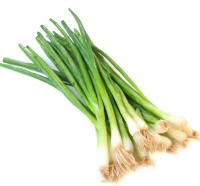 Scallions
(Allium cepa) - Also known as green onions and spring onions, scallion
isn't a species unto itself, but the immature form of several varieties of the
common onion. Although they may be eaten cooked, scallions are prized for their
potent flavor and are usually used raw. Both the green and white parts are
edible, and the green foliage is much milder than the white bulb portion of the
plant. They are an essential component of and garnish to many stir-fried dishes
of Asia, and are equally at home in French and Mexican dishes. Scallions
(Allium cepa) - Also known as green onions and spring onions, scallion
isn't a species unto itself, but the immature form of several varieties of the
common onion. Although they may be eaten cooked, scallions are prized for their
potent flavor and are usually used raw. Both the green and white parts are
edible, and the green foliage is much milder than the white bulb portion of the
plant. They are an essential component of and garnish to many stir-fried dishes
of Asia, and are equally at home in French and Mexican dishes.
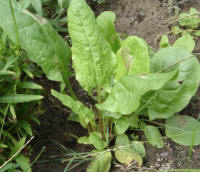 Sorrel
(genus Rumex) - The species of this member of the buckwheat family have
leaves shaped similar to spinach, but are easy to distinguish because of their
tart acidity caused by high concentrations of oxalic acid. They can be eaten raw
in salads or cooked in sauces and soups. Rumex scutatus, also known as
French sorrel, sour dock, and sour grass, is preferred. The more common
Rumex acetosa is also known as dock sorrel and spinach dock. All are
evergreen perennials that do well under most conditions. Sorrel
(genus Rumex) - The species of this member of the buckwheat family have
leaves shaped similar to spinach, but are easy to distinguish because of their
tart acidity caused by high concentrations of oxalic acid. They can be eaten raw
in salads or cooked in sauces and soups. Rumex scutatus, also known as
French sorrel, sour dock, and sour grass, is preferred. The more common
Rumex acetosa is also known as dock sorrel and spinach dock. All are
evergreen perennials that do well under most conditions.
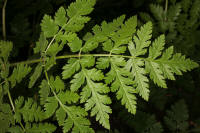 Sweet
Cicely (Myrrhis odorata) - The leaves of this compact perennial have a
flavor reminiscent of celery and anise. They are used in breads and baked goods,
and are said to reduce the tartness of gooseberries and rhubarb when cooked
together. They add an unusual sweet spiciness to egg and cheese dishes, soups,
and salads. Sweet
Cicely (Myrrhis odorata) - The leaves of this compact perennial have a
flavor reminiscent of celery and anise. They are used in breads and baked goods,
and are said to reduce the tartness of gooseberries and rhubarb when cooked
together. They add an unusual sweet spiciness to egg and cheese dishes, soups,
and salads.
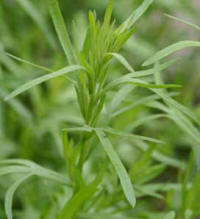 Tarragon
(Artemisia dracunculus) - The fresh, anise-like flavor of this
perennial herb is used to great success in many classic French preparations such
as sauce Béarnaise and fines herbes. Although it retains some of its flavor when
dried, fresh tarragon is much preferred. Tarragon branches and leaves are often
steeped in vinegar, and tarragon vinegar imparts the unique flavor of the herb
to any dish it is used in. Since the plant seldom (if ever) sets seeds, it must
be propagated by cuttings or root divisions. Beware of other, inferior imitators
such as "Russian tarragon" and "Texas tarragon." Tarragon
(Artemisia dracunculus) - The fresh, anise-like flavor of this
perennial herb is used to great success in many classic French preparations such
as sauce Béarnaise and fines herbes. Although it retains some of its flavor when
dried, fresh tarragon is much preferred. Tarragon branches and leaves are often
steeped in vinegar, and tarragon vinegar imparts the unique flavor of the herb
to any dish it is used in. Since the plant seldom (if ever) sets seeds, it must
be propagated by cuttings or root divisions. Beware of other, inferior imitators
such as "Russian tarragon" and "Texas tarragon."
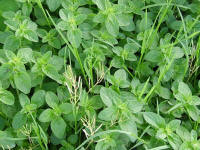 Thyme
(Thymus vulgaris) - Several varieties of thyme are available to the
home gardener, including broad-leafed English thyme, narrow-leafed French thyme,
low-growing wooly thyme, and the citrusy lemon thyme. It is one of the basic
herbs used in French and Caribbean cooking, and is used to flavor just about
everything. It is a hardy, long-lived perennial that does well in full sun and
almost any soil. Thyme
(Thymus vulgaris) - Several varieties of thyme are available to the
home gardener, including broad-leafed English thyme, narrow-leafed French thyme,
low-growing wooly thyme, and the citrusy lemon thyme. It is one of the basic
herbs used in French and Caribbean cooking, and is used to flavor just about
everything. It is a hardy, long-lived perennial that does well in full sun and
almost any soil.
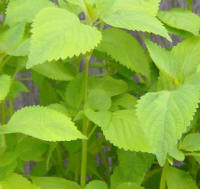 Vietnamese
Balm (Elsholtzia ciliata) - This perennial is native to the temperate
regions of southern and central Asia where it is used to flavor fish, eggs,
vegetables, noodles, and rice dishes, and is frequently included in the platter
of mixed greens served at almost every Vietnamese meal. In Thailand it is served
as a vegetable. Not widely available in the West, it can be found in markets
where there is a sizeable Vietnamese population. It is often cultivated as an
annual, and store-bough cutting are easily rooted in water for planting in the
garden. Vietnamese
Balm (Elsholtzia ciliata) - This perennial is native to the temperate
regions of southern and central Asia where it is used to flavor fish, eggs,
vegetables, noodles, and rice dishes, and is frequently included in the platter
of mixed greens served at almost every Vietnamese meal. In Thailand it is served
as a vegetable. Not widely available in the West, it can be found in markets
where there is a sizeable Vietnamese population. It is often cultivated as an
annual, and store-bough cutting are easily rooted in water for planting in the
garden.
 Watercress
(Nasturtium offinale) - Watercress grows wild throughout the northern
hemisphere, and is a valuable food product in many parts of the world. Often
used as a salad green and valued for its mild peppery flavor that doesn't
overpower foods, it is also used purely as a flavor component in soups and
sauces. An aquatic plant that will grow on land given abundant moisture, the
flavor and tenderness of plants grown this way doesn't compare to those grown
fully submerged, and is therefore not recommended for the home gardener. Watercress
(Nasturtium offinale) - Watercress grows wild throughout the northern
hemisphere, and is a valuable food product in many parts of the world. Often
used as a salad green and valued for its mild peppery flavor that doesn't
overpower foods, it is also used purely as a flavor component in soups and
sauces. An aquatic plant that will grow on land given abundant moisture, the
flavor and tenderness of plants grown this way doesn't compare to those grown
fully submerged, and is therefore not recommended for the home gardener.
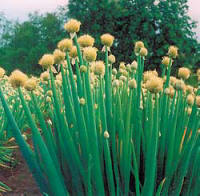 Welsh
Onions (Allium fistolum) - Very similar in appearance and use to
scallions, Welsh onions are often mislabeled with that name in supermarkets.
Even the name Welsh onion is a misnomer as these perennials are native to
Siberia. They are also called Japanese bunching onions and are the largest onion
crop grown in Asia. They are used as scallions and are considerably milder in
flavor that their close cousins. Welsh
Onions (Allium fistolum) - Very similar in appearance and use to
scallions, Welsh onions are often mislabeled with that name in supermarkets.
Even the name Welsh onion is a misnomer as these perennials are native to
Siberia. They are also called Japanese bunching onions and are the largest onion
crop grown in Asia. They are used as scallions and are considerably milder in
flavor that their close cousins.
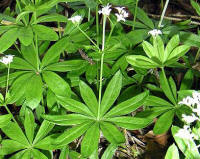 Woodruff
(Galium odoratum) - Also known as sweet woodruff, the common name
belies its natural habitat of the woodland forests of northern Europe, and the
species name tells us why it is valued in the kitchen. The leaves and flowers of
the low-growing hardy perennial have an aroma of freshly mown hay laced with a
touch of vanilla, and have been used to flavor traditional beverages such as the
German Waldmeisterbowle, or May wine, for centuries. It can also be
used to flavor marinades for chicken and wild game, and is often added as a
flavoring agent to sorbet and sabayon. Woodruff
(Galium odoratum) - Also known as sweet woodruff, the common name
belies its natural habitat of the woodland forests of northern Europe, and the
species name tells us why it is valued in the kitchen. The leaves and flowers of
the low-growing hardy perennial have an aroma of freshly mown hay laced with a
touch of vanilla, and have been used to flavor traditional beverages such as the
German Waldmeisterbowle, or May wine, for centuries. It can also be
used to flavor marinades for chicken and wild game, and is often added as a
flavoring agent to sorbet and sabayon.
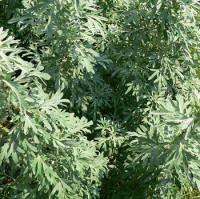 Wormwood
(Artemisia absinthium) - This attractive, wooly, grey perennial has
long been used for cooking in parts of Europe, but its primary use has been to
flavor beverages such as absinthe and vermouth. Because its oils are potentially
toxic, products containing more than a trace amount of wormwood extract are
banned from sale in the United States. Wormwood
(Artemisia absinthium) - This attractive, wooly, grey perennial has
long been used for cooking in parts of Europe, but its primary use has been to
flavor beverages such as absinthe and vermouth. Because its oils are potentially
toxic, products containing more than a trace amount of wormwood extract are
banned from sale in the United States.
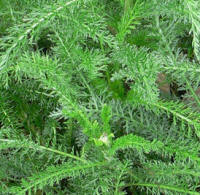 Yarrow
(Achillea millefolium) - A popular plant in the perennial border
because of its attractive yellow flower heads, the leaves are often used in
salads, soups, teas, and occasionally egg dishes. Also known as milfoil, its
intense bitter, peppery, perfume-like flavor is best used in moderation. Yarrow
(Achillea millefolium) - A popular plant in the perennial border
because of its attractive yellow flower heads, the leaves are often used in
salads, soups, teas, and occasionally egg dishes. Also known as milfoil, its
intense bitter, peppery, perfume-like flavor is best used in moderation.
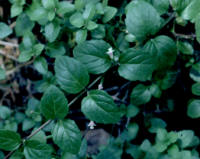 Yerba
Buena (Clinopodium douglasii) - A close relative to summer and winter
savory, yerba buena means "good herb" in Spanish, a term used generically by
Spanish colonists to describe any minty herb. It is used to flavor beverages and
soups throughout its native range in Central America. It is sometimes called
Indian mint. Yerba
Buena (Clinopodium douglasii) - A close relative to summer and winter
savory, yerba buena means "good herb" in Spanish, a term used generically by
Spanish colonists to describe any minty herb. It is used to flavor beverages and
soups throughout its native range in Central America. It is sometimes called
Indian mint.
Copyright © 2005 by Worldwide Recipes. All rights reserved.
|